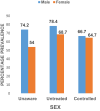Prevalence, Awareness, and Factors Associated with Hypertension Among Adults in Rural Southwestern Uganda: A Baseline Survey
- PMID: 40575767
- PMCID: PMC12199733
- DOI: 10.2147/IJGM.S522911
Prevalence, Awareness, and Factors Associated with Hypertension Among Adults in Rural Southwestern Uganda: A Baseline Survey
Abstract
Background: Hypertension is the leading cause of preventable deaths globally. However, reports on its prevalence and risk factors in rural sub-Saharan Africa have been inconsistent, making targeted interventions challenging. This study examines the prevalence, awareness, and associated factors of hypertension among adults in a rural community in southwestern Uganda.
Methods: We conducted a baseline survey in Ngango, Mbarara district, enrolling adults aged 18-79 years from eleven villages. Research assistants and community health workers recruited participants from their homes using the WHO STEPS questionnaire, collecting data on demographics, lifestyle behaviors (tobacco and alcohol use, diet, and physical activity), and other risk factors. Blood pressure (BP) was measured three times, with hypertension defined as BP ≥140/90 mmHg or self-reported antihypertensive use. Logistic regression was applied to identify factors associated with hypertension.
Results: A total of 953 adults were enrolled, with a median age of 43 years (IQR: 30-57). Women accounted for 61.5%, and only 43.5% recalled ever having their blood pressure measured. Hypertension prevalence was 27.3%, with 61.5% of cases undiagnosed. Among those receiving treatment (27.7%), 65.3% had controlled blood pressure. Despite 66.8% of participants reporting regular physical activity, 63.7% were overweight. The key factors associated with hypertension included age over 40 years (OR: 2.26), consuming fewer than three servings of fruits or vegetables per week (OR: 1.62), and being overweight (OR: 1.57) or obese (OR: 2.73).
Conclusion: Hypertension is highly prevalent in rural southwestern Uganda, underscoring the need for targeted interventions-especially within a relatively young and physically active population.
Keywords: Sub-Saharan Africa; blood pressure; cardiovascular disease; hypertension; rural Uganda.
Plain language summary
Hypertension (high blood pressure) is a leading cause of preventable deaths worldwide. However, data on its impact and risk factors in rural sub-Saharan Africa remain inconsistent, making targeted interventions challenging. This study examines the prevalence, awareness, and associated factors of hypertension in a rural community in southwestern Uganda. We conducted a community-based survey across all eleven villages of Ngango Parish, Mbarara District, enrolling adults aged 18–79 years. Research assistants and community health workers collected demographic data (age, sex), behavioral factors (smoking and alcohol consumption), and lifestyle characteristics (diet and physical activity) through household visits. Blood pressure was measured three times while participants were seated comfortably. Hypertension was defined as blood pressure ≥140/90 mmHg or self-reported use of antihypertensive medication. We performed statistical analysis to identify factors associated with hypertension. Results: We enrolled 953 participants with a median age of 43 years. Women constituted the majority (61.5%). Hypertension was present in 27.3% of individuals, yet awareness was low—only 38.5% knew they had the condition, and just 27.7% were receiving treatment. Despite 66.8% of participants reporting good physical activity, more than half (63.7%) were overweight (BMI > 25 kg/m²). Key factors associated with hypertension included age over 40 years, consuming fewer than three servings of fruits or vegetables per week, and being overweight or obese. We conclude that hypertension is common in rural southwestern Uganda, affecting even younger and physically active individuals. This highlights the urgent need for targeted health interventions to address hypertension in these communities.
© 2025 Kansiime et al.
Conflict of interest statement
Dr. Grace Kansiime is a Fogarty Global Health Fellow supported by the Fogarty International Centre (NIH Grant number D43TW010543) and reports personal fees from AstraZeneca Pharmaceuticals, grants from NIH, non-financial support from Phillips Pharm Ltd (Microlabs) outside the submitted work. Edwin Nuwagira is supported by the Fogarty International Institute (Grant number K43TW012781). The authors report no other conflicts of interest in this work.
Figures
Similar articles
-
Replacing salt with low-sodium salt substitutes (LSSS) for cardiovascular health in adults, children and pregnant women.Cochrane Database Syst Rev. 2022 Aug 10;8(8):CD015207. doi: 10.1002/14651858.CD015207. Cochrane Database Syst Rev. 2022. PMID: 35944931 Free PMC article.
-
Sexual Harassment and Prevention Training.2024 Mar 29. In: StatPearls [Internet]. Treasure Island (FL): StatPearls Publishing; 2025 Jan–. 2024 Mar 29. In: StatPearls [Internet]. Treasure Island (FL): StatPearls Publishing; 2025 Jan–. PMID: 36508513 Free Books & Documents.
-
Community wide interventions for increasing physical activity.Cochrane Database Syst Rev. 2015 Jan 5;1(1):CD008366. doi: 10.1002/14651858.CD008366.pub3. Cochrane Database Syst Rev. 2015. PMID: 25556970 Free PMC article.
-
Behavioral interventions to reduce risk for sexual transmission of HIV among men who have sex with men.Cochrane Database Syst Rev. 2008 Jul 16;(3):CD001230. doi: 10.1002/14651858.CD001230.pub2. Cochrane Database Syst Rev. 2008. PMID: 18646068
-
Population-based biomedical sexually transmitted infection control interventions for reducing HIV infection.Cochrane Database Syst Rev. 2011 Mar 16;(3):CD001220. doi: 10.1002/14651858.CD001220.pub3. Cochrane Database Syst Rev. 2011. PMID: 21412869
References
-
- World Health Organization. A Global Report on Hypertension: The Race Against a Silent Killer; 2023.
Grants and funding
LinkOut - more resources
Full Text Sources




